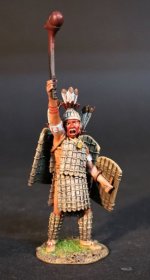- Joined
- Feb 2, 2011
- Messages
- 2,093
NEW RELEASES FOR DECEMBER 2022
THE CONQUEST OF AMERICA
THE POWHATAN
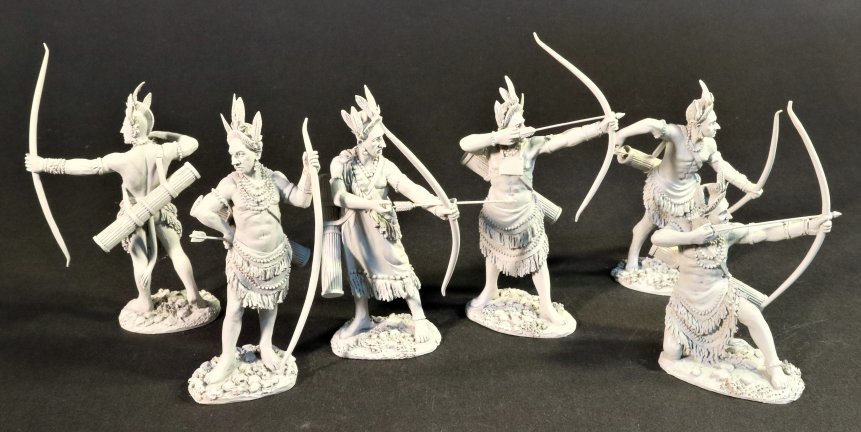
The Powhatan people may refer to any of the indigenous Algonquian people that are traditionally from eastern Virginia. It is estimated that there were about 14,000-21,000 Powhatan people in eastern Virginia, when English colonists established Jamestown in 1607.
In the late 16[SUP]th[/SUP] and early 17[SUP]th[/SUP] centuries, a “Mamanatowick” (paramount chief) named Wahunsenacawh created an organization by affiliating 30 tributary peoples, whose territory was much of eastern Virginia.
They called this area Tsenacommacah (“densely inhabited land”).
Wahunsenacawh came to be known by English colonists as “The Powhatan Chief”.
Each of the tribes within this organization had its own Weroance (leader), but all paid tribute to the Powhatan Chief.
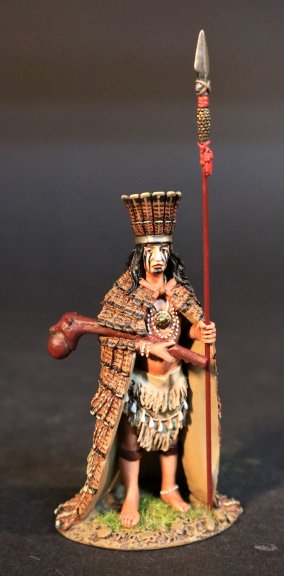
POW-01
THE CONQUEST OF AMERICA,
THE POWHATAN
POWHATAN CHIEF OPCHANACANOUGH.
(2 pcs)
After Wahunsenacawh’s death in 1618, hostilities with colonists escalated under the chiefdom of his brother, Opchanacanough, who sought in vain to expel encroaching English colonists.
His large scale attacks in 1622 and 1644 met strong reprisals by the colonists, resulting in near elimination of the tribe.
By 1646, what is called the Powhattan Paramount Chiefdom by modern historians had been decimated.
More important than the ongoing conflicts with the English colonial settlements was the high rate of deaths the Powhattan suffered due to new infectious diseases carried to North America by Europeans, such as measles and smallpox.
The native Americans did not have any immunity to these, which had been endemic in Europe and Asia for centuries. The wholesale deaths greatly weakened and hollowed out the native American societies.
By the mid-17[SUP]th[/SUP] century, the leaders of the colony were desperate for labor to develop the land. Almost half of the European immigrants to Virginia arrived as indentured servants.
As settlements continued, the colonists imported growing numbers of enslaved Africans for labour.
By 1700 the colonies had about 6,000 black slaves, which was one-twelfth of the population.
After Bacon’s Rebellion in 1676, the colony enslaved the native Americans for control. In 1691, the House of Burgesses abolished native slavery, however many Powhatan were held in servitude well into the 18[SUP]th[/SUP] Century.
There are several detailed accounts of the Powhatan peoples, but we are fortunate to have the exquisite water-colours of John White, who was the governor of the second Roanoke Settlement.
Luck would have it he was gathering supplies in England when his colony vanished.
The main weapon of all the Indians faced by the English settlers during this period was the longbow. This measured 5-6ft. and was made from witch-hazel or hickory.
It was noted that the Indian bows were quick, but not very strong or accurate.
THE BEAVER WARS 1640 – 1701
Starting in 1640, there was an intermittent war fought over one of the most in demand, luxurious items in the world: beaver pelts. The war was fought between the Iroquois Confederacy of the St. Lawrence River area and the Algonquian-speaking tribes of the Ohio Country and the Great Lakes, who were backed by the French. These wars took place in the Great Lakes region.
The Iroquois Confederacy was made up of five tribes that all spoke the Iroquois language: the Mohawk, Oneida, Onondaga, Cayuga and Seneca. These tribes were involved in the fur trade for over 200 years prior to the war. The Iroquois traded beaver pelts to British settlers and merchants. In return, the Iroquois received items that they depended on, such as tools and firearms.
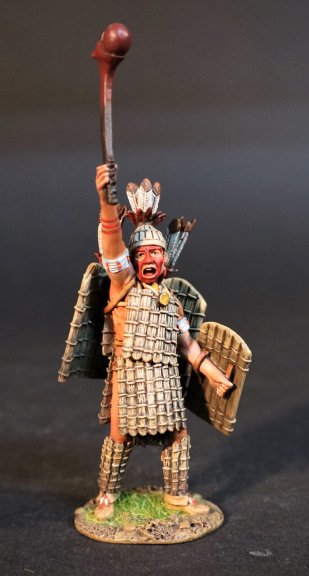
BV-01
THE CONQUEST OF AMERICA,
THE BEAVER WARS 1640 - 1701.
IROQUOIS ARMOURED WARRIOR.
(1 pcs)
By the mid-17th century, the Iroquois had hunted the beaver to near depletion in the St. Lawrence River area. Needing beaver pelts to trade for much needed items, the Iroquois expanded their hunting to the Ohio Country. When they did this the Iroquois ran into other tribes in the region who also traded beaver fur. These tribes included the Algonquian-speaking tribes, such as the Lenape and the Delaware, and the French merchants that supported them.
This accidental meeting led to a series of battles and bitter rivalries that lasted over 60 years. Each side was vying to be the main supplier in the lucrative beaver pelt trade.
Although the Iroquois Confederacy could be considered victors as they conquered most of the Ohio Country, they too suffered and lost much in the process. Iroquois homes and agricultural land were often burnt down by the French.
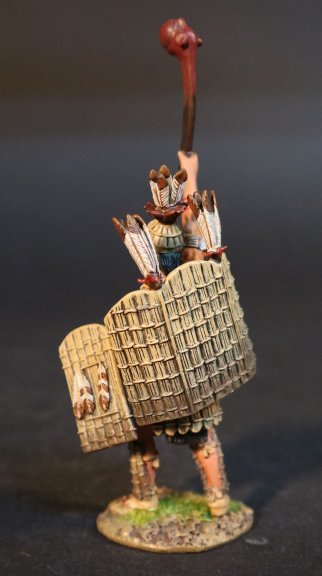
In 1701, the Treaty of Grande Paix was signed by the British, the French, the Iroquois Confederacy and the tribes of the Great Lakes. The treaty did not push the French out of the territory, but it did solidify an alliance between the Iroquois Confederacy and the British that would later help both in the French and Indian War.
The wars and subsequent commercial trapping of beavers was devastating to the local beaver population. Trapping continued to spread across North America, extirpating or severely reducing populations across the continent. The natural ecosystems that came to rely on the beavers for dams, water and other vital needs were also devastated leading to ecological destruction, environmental change, and drought in certain areas. The beaver populations in North America would take centuries to recover in some areas, while others would never recover.
PLEASE CONTACT YOUR LOCAL DEALER FOR FURTHER INFORMATION
THE CONQUEST OF AMERICA
THE POWHATAN

The Powhatan people may refer to any of the indigenous Algonquian people that are traditionally from eastern Virginia. It is estimated that there were about 14,000-21,000 Powhatan people in eastern Virginia, when English colonists established Jamestown in 1607.
In the late 16[SUP]th[/SUP] and early 17[SUP]th[/SUP] centuries, a “Mamanatowick” (paramount chief) named Wahunsenacawh created an organization by affiliating 30 tributary peoples, whose territory was much of eastern Virginia.
They called this area Tsenacommacah (“densely inhabited land”).
Wahunsenacawh came to be known by English colonists as “The Powhatan Chief”.
Each of the tribes within this organization had its own Weroance (leader), but all paid tribute to the Powhatan Chief.

POW-01
THE CONQUEST OF AMERICA,
THE POWHATAN
POWHATAN CHIEF OPCHANACANOUGH.
(2 pcs)
After Wahunsenacawh’s death in 1618, hostilities with colonists escalated under the chiefdom of his brother, Opchanacanough, who sought in vain to expel encroaching English colonists.
His large scale attacks in 1622 and 1644 met strong reprisals by the colonists, resulting in near elimination of the tribe.
By 1646, what is called the Powhattan Paramount Chiefdom by modern historians had been decimated.
More important than the ongoing conflicts with the English colonial settlements was the high rate of deaths the Powhattan suffered due to new infectious diseases carried to North America by Europeans, such as measles and smallpox.
The native Americans did not have any immunity to these, which had been endemic in Europe and Asia for centuries. The wholesale deaths greatly weakened and hollowed out the native American societies.
By the mid-17[SUP]th[/SUP] century, the leaders of the colony were desperate for labor to develop the land. Almost half of the European immigrants to Virginia arrived as indentured servants.
As settlements continued, the colonists imported growing numbers of enslaved Africans for labour.
By 1700 the colonies had about 6,000 black slaves, which was one-twelfth of the population.
After Bacon’s Rebellion in 1676, the colony enslaved the native Americans for control. In 1691, the House of Burgesses abolished native slavery, however many Powhatan were held in servitude well into the 18[SUP]th[/SUP] Century.
There are several detailed accounts of the Powhatan peoples, but we are fortunate to have the exquisite water-colours of John White, who was the governor of the second Roanoke Settlement.
Luck would have it he was gathering supplies in England when his colony vanished.
The main weapon of all the Indians faced by the English settlers during this period was the longbow. This measured 5-6ft. and was made from witch-hazel or hickory.
It was noted that the Indian bows were quick, but not very strong or accurate.
THE BEAVER WARS 1640 – 1701
Starting in 1640, there was an intermittent war fought over one of the most in demand, luxurious items in the world: beaver pelts. The war was fought between the Iroquois Confederacy of the St. Lawrence River area and the Algonquian-speaking tribes of the Ohio Country and the Great Lakes, who were backed by the French. These wars took place in the Great Lakes region.
The Iroquois Confederacy was made up of five tribes that all spoke the Iroquois language: the Mohawk, Oneida, Onondaga, Cayuga and Seneca. These tribes were involved in the fur trade for over 200 years prior to the war. The Iroquois traded beaver pelts to British settlers and merchants. In return, the Iroquois received items that they depended on, such as tools and firearms.

BV-01
THE CONQUEST OF AMERICA,
THE BEAVER WARS 1640 - 1701.
IROQUOIS ARMOURED WARRIOR.
(1 pcs)
By the mid-17th century, the Iroquois had hunted the beaver to near depletion in the St. Lawrence River area. Needing beaver pelts to trade for much needed items, the Iroquois expanded their hunting to the Ohio Country. When they did this the Iroquois ran into other tribes in the region who also traded beaver fur. These tribes included the Algonquian-speaking tribes, such as the Lenape and the Delaware, and the French merchants that supported them.
This accidental meeting led to a series of battles and bitter rivalries that lasted over 60 years. Each side was vying to be the main supplier in the lucrative beaver pelt trade.
Although the Iroquois Confederacy could be considered victors as they conquered most of the Ohio Country, they too suffered and lost much in the process. Iroquois homes and agricultural land were often burnt down by the French.

In 1701, the Treaty of Grande Paix was signed by the British, the French, the Iroquois Confederacy and the tribes of the Great Lakes. The treaty did not push the French out of the territory, but it did solidify an alliance between the Iroquois Confederacy and the British that would later help both in the French and Indian War.
The wars and subsequent commercial trapping of beavers was devastating to the local beaver population. Trapping continued to spread across North America, extirpating or severely reducing populations across the continent. The natural ecosystems that came to rely on the beavers for dams, water and other vital needs were also devastated leading to ecological destruction, environmental change, and drought in certain areas. The beaver populations in North America would take centuries to recover in some areas, while others would never recover.
PLEASE CONTACT YOUR LOCAL DEALER FOR FURTHER INFORMATION


